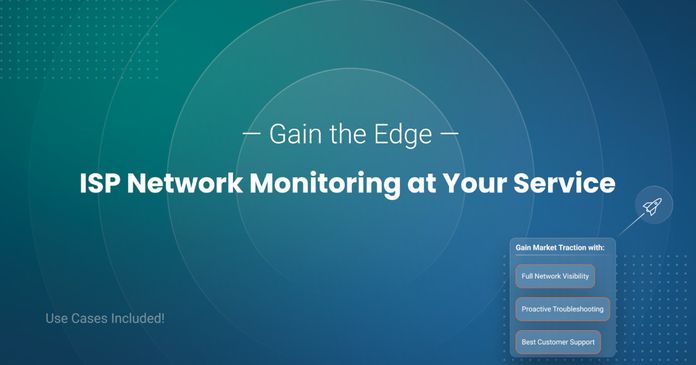Table of Contents
Table of Contents
MSPs (Managed Service Providers) have a lot of responsibility on their shoulders. They need to look after the IT infrastructures or networks of their customers to ensure that they’re always up and running. But, what happens when the MSP network itself isn’t performing like it should? Like a business organization, an MSP also faces repercussions due to network downtime. Even a minute of downtime can prevent an MSP from offering the necessary services to its clients.
For Managed Service Providers (MSPs), business operations rely heavily on seamless network functionality. As MSPs and network administrators navigate the intricate web of interconnected devices, applications, and users, the need for a robust and proactive network monitoring strategy has never been more crucial.
This blog post is crafted as a guiding compass for MSPs looking to elevate their network monitoring game and gain comprehensive visibility into network performance between their network and their customer’s networks. From optimizing performance and ensuring uptime to swiftly identifying and mitigating potential issues, we'll explore the tools, methodologies, and best practices that form the bedrock of successful network oversight.
Whether you're a seasoned network administrator or an MSP looking to enhance your service offerings, this guide aims to equip you with the insights needed to create a resilient, responsive, and efficient network monitoring strategy.
For MSPs, the success of businesses relies heavily on technology infrastructure. MSPs serve as the backbone of a company's IT support, responsible for ensuring the seamless functioning of networks that connect devices, applications, and users.
According to Carbonite, if the IT system of a small or medium-sized business (SMB) goes down for just 1 hour, that could cost them $25,620, or $427.00 per minute. MSPs need to ensure that that doesn’t happen for them, or their customers.
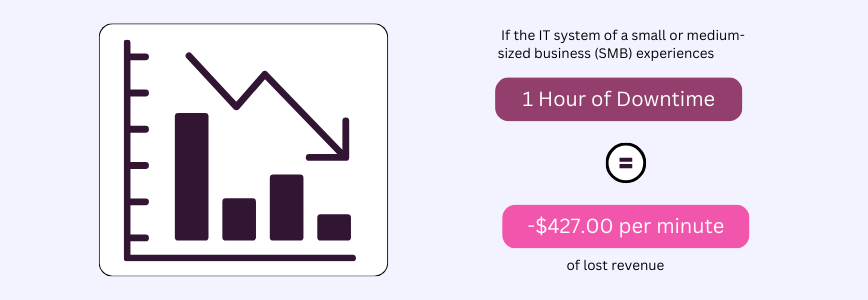
To do that, they need to monitor their networks and their customers' networks to ensure that their services are working as they should be. Here’s why:
I. Maximizing Uptime and Productivity:
Downtime translates directly to lost productivity and revenue for businesses. Effective network monitoring allows MSPs to proactively identify and address issues before they escalate, ensuring that networks remain operational, and network downtime is minimized.
II. Mitigating Risks and Enhancing Security:
In an era where cyber threats are constantly evolving, MSPs must act as the first line of defence for their clients. Network monitoring tools play a pivotal role in detecting anomalies, security breaches, and potential vulnerabilities. This proactive approach is crucial for safeguarding sensitive data and maintaining the trust of clients.
III. Meeting Service Level Agreements (SLAs):
MSPs operate within the framework of service level agreements, committing to specific performance standards and response times. Effective network monitoring not only helps in meeting and monitoring SLAs but also allows MSPs to exceed client expectations by identifying and addressing issues before they impact service delivery.
IV. Optimizing Performance and Scalability:
The scalability and performance of a network are pivotal for businesses that are growing or adapting to changing demands. Monitoring tools provide insights into network performance metrics, helping MSPs optimize resources, plan for future expansion, and ensure that the network infrastructure aligns with business objectives.
V. Enhancing Customer Experience:
A seamless and responsive IT environment directly contributes to a positive customer experience. By proactively monitoring networks, MSPs can prevent disruptions, reduce response times, and enhance overall user satisfaction. This, in turn, solidifies the MSP's reputation and fosters long-term client relationships.
VI. Strategic Decision-Making:
Data-driven decision-making is at the core of successful MSP operations. Network monitoring tools generate valuable data and insights that empower MSPs to make informed decisions about resource allocation, infrastructure upgrades, and strategic planning, ultimately contributing to the growth and competitiveness of the MSP business.
In conclusion, effective network monitoring is not just a task within the MSP toolkit; it is a cornerstone of success. As the digital landscape continues to evolve, MSPs that prioritize proactive and comprehensive network monitoring will not only meet the immediate needs of their clients but will also position themselves as invaluable partners in the journey of sustained business growth and innovation.
In the hustle and bustle of managing other folks' IT worlds, downtime is the ultimate nemesis - and a robust Network Monitoring tool is the way to avoid downtime! Obkio's cutting-edge Network Performance Monitoring tool is the ultimate solution to help MSPs monitor their networks to ensure uptime and availability for them and their customers!
Why Obkio?

- Real-Time Visibility: Gain instant insights into your network's performance, allowing you to proactively address issues before they impact your clients.
- Performance Issues Stand No Chance: Obkio's tool is designed to not only monitor performance but also detect and mitigate network issues, ensuring optimal uptime of your MSP network.
- Scalability and Adaptability: Whether you're managing a small network or a vast infrastructure, Obkio's solution scales with your needs, providing flexibility and adaptability to diverse client requirements.
- Client-Friendly Reporting: Impress your clients with comprehensive and easy-to-understand reports, showcasing the proactive measures you've taken to keep their networks running seamlessly.
Ready to Take the Next Step?
Visit Obkio's Website to explore how their Network Monitoring tool can revolutionize the way you oversee MSP networks. Request a demo today and discover firsthand how Obkio empowers MSPs not only to meet but also exceed client expectations, ensuring unparalleled network performance and reliability.
Elevate your network monitoring game with Obkio – where every connection matters.

Before we get into how to monitor MSP networks, we have to first understand what MSP networks look like. This entails not only a comprehensive overview of MSP network architecture but also a keen awareness of the key components and their intricate interdependencies. Let's delve into these aspects of the MSP network landscape.
The architecture of an MSP network is the structural framework that underpins the entire infrastructure. It's akin to the blueprint that guides the construction of a reliable and efficient digital ecosystem. MSP networks, by virtue of their role in managing the IT infrastructure of diverse clients, often exhibit a sophisticated architecture designed for scalability, security, and optimal performance.
Typically, an MSP network architecture encompasses:
- Core Infrastructure: The central nervous system of the network, including servers, routers, and switches, forms the core infrastructure. This is where the fundamental processing and routing of data take place.
- Connectivity Components: Networks rely on various connectivity elements such as firewalls, gateways, and VPNs to ensure secure and seamless communication. These components act as gatekeepers, safeguarding the network from unauthorized access and potential threats.
- Cloud Integration: In the contemporary IT landscape, the integration of cloud services is a common feature in MSP network architectures. This involves the incorporation of cloud-based storage, applications, and services to enhance flexibility and scalability.
- Monitoring and Management Tools: Given the critical role of MSPs in ensuring the health and performance of client networks, monitoring and management tools are integral components. These tools provide real-time insights into network activities, performance metrics, and potential issues.
The effectiveness of an MSP network lies in understanding the nuanced relationships between its key components and the dependencies that exist among them. Identifying these components and interdependencies is akin to deciphering the network's language, enabling MSPs to proactively manage and optimize its performance.
- Devices and Endpoints: From servers and workstations to IoT devices, each endpoint plays a role in the overall network ecosystem. Understanding the diversity of devices and their functions is crucial for anticipating potential vulnerabilities and ensuring seamless connectivity.
- Network Protocols and Communication Channels: MSPs must have a grasp of the various protocols governing communication within the network. Whether it's TCP/IP, HTTP, or other protocols, understanding how data travels through the network is essential for effective troubleshooting and optimization.
- Security Measures: Security components, including firewalls, intrusion detection systems, and encryption protocols, form the bulwark against cyber threats. Recognizing the role each security measure plays and their interplay is vital for safeguarding the integrity of the network.
- Bandwidth and Traffic Management: The flow of data and the management of bandwidth are critical considerations in network performance. Identifying the points of congestion, optimizing traffic routing, and ensuring sufficient bandwidth are key factors in preventing bottlenecks.
- Integration with Client Environments: MSP networks are not standalone entities; they integrate with the diverse environments of their clients. Understanding the nuances of integration, such as compatibility with client systems and applications, is imperative for seamless service delivery.
In essence, understanding the MSP network environment involves peeling back the layers of complexity to reveal the interconnected web of components and dependencies. Armed with this knowledge, MSPs can navigate challenges, optimize performance, and provide clients with a robust and reliable IT infrastructure.
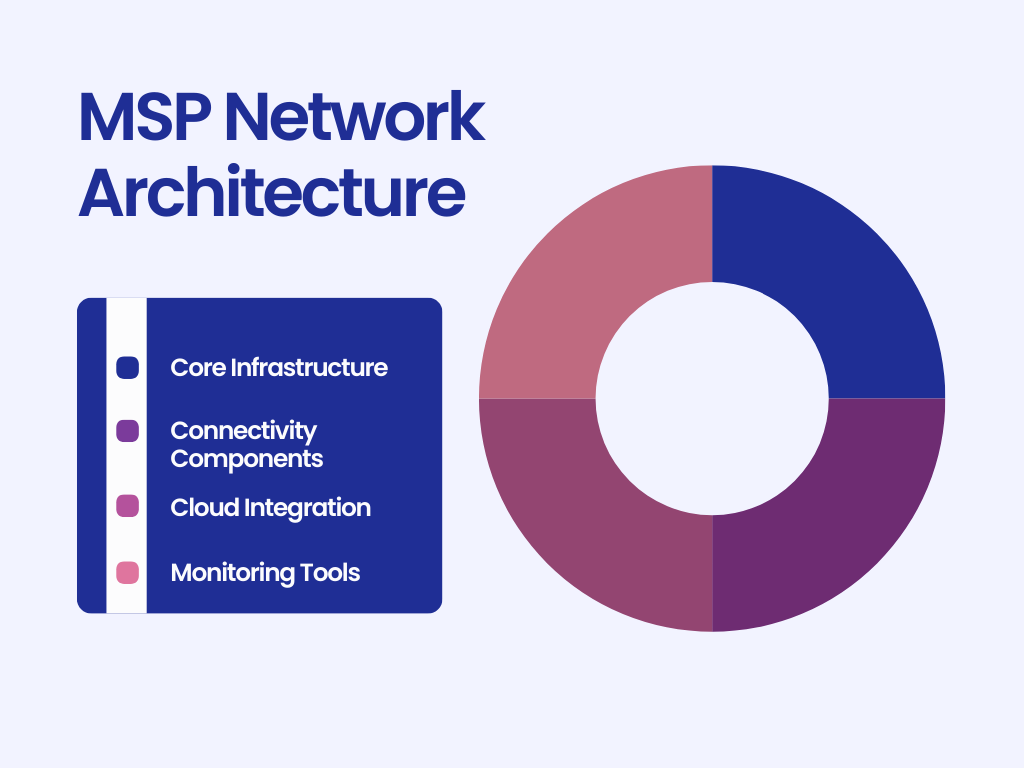

Ensuring a remarkable uptime, or achieving the coveted 99.99% benchmark, is a crucial task for Managed Service Providers (MSPs). However there are some challenges hindering MSPs from optimizing their uptime, and these challenges are intricately woven into the fabric of their IT infrastructure management.
Let’s explore:
MSPs grapple with the unpredictability of service issues within their IT infrastructure, primarily stemming from a dearth of effective monitoring tools. The absence of robust tools for application performance and cloud monitoring poses a significant concern, leading to unforeseen network outages that directly impact service availability.
Traditional network monitoring solutions, while well-intentioned, inundate MSPs with a barrage of alerts whenever an IT incident occurs. The sheer volume of alerts poses a challenge. As MSPs struggle to understand which alerts require immediate attention, it affects the response time for addressing and troubleshooting important issues as fast as possible.
Outdated monitoring solutions fall short of identifying patterns between IT events, rendering MSPs unable to predict performance issues. This deficiency often results in unplanned shutdowns, further emphasizing the need for advanced event correlation technology to navigate the complexities of the modern IT landscape.
MSPs, responding to burgeoning demands, have scaled up the size and complexity of their IT infrastructure. However, this expansion has outpaced the available workforce, making it challenging for MSPs to manage the intricate web of their IT environment, ultimately jeopardizing efforts to maintain high uptime.
A crucial element in ensuring high uptime is the observability of the IT infrastructure and software systems. MSPs grapple with poor visibility into the internal states of these systems, inhibiting their ability to enhance uptime and navigate the intricacies of modern IT environments effectively.
In the face of these challenges, MSPs are turning to reliable automation technology as the key to managing the ever-growing complexity of IT infrastructure. Enter Network Monitoring for MSPs - the ultimate solution for monitoring network performance for MSP networks, all the way to their customer networks.
So how do you deploy and use MSP Network Monitoring to ensure high performance visibility and uptime? Let’s get into it!

In the world of Managed Service Providers (MSPs), network monitoring is a must. MSPs have a unique challenge - keeping both their own network and their clients' networks in top shape, ensuring uptime, availability, and a watchful eye for potential issues.
Enter, Network Monitoring Tools! These tools serve as vigilant guardians, allowing MSPs to track the entirety of their network infrastructure, from internal operations to client connections. By adopting end-to-end monitoring, MSPs gain a holistic view, enabling them to identify bottlenecks, pinpoint performance issues, and ensure seamless connectivity across the entire network spectrum.
These tools not only enhance visibility into the MSP's own network performance but also extend their reach to monitor the interactions and interdependencies between the MSP's network and those of their clients. With a finger on the pulse of end-to-end network activities, MSPs can proactively address potential challenges, minimize downtime, and deliver a consistently reliable service to their clients. The result is a more resilient and responsive network environment, aligning with the high standards of performance and availability expected in the dynamic landscape of managed services.
To start monitoring your MSP network, you need to find the right solution for your business. That's where Obkio’s MSP Network Monitoring Solution comes in.
Obkio is a synthetic, end-to-end Network Monitoring SaaS solution that empowers IT pros to continuously monitor and troubleshoot network performance. Using distributed Monitoring Agents, MSP, ISPs, businesses and customers can monitor network performance from all distributed network locations.
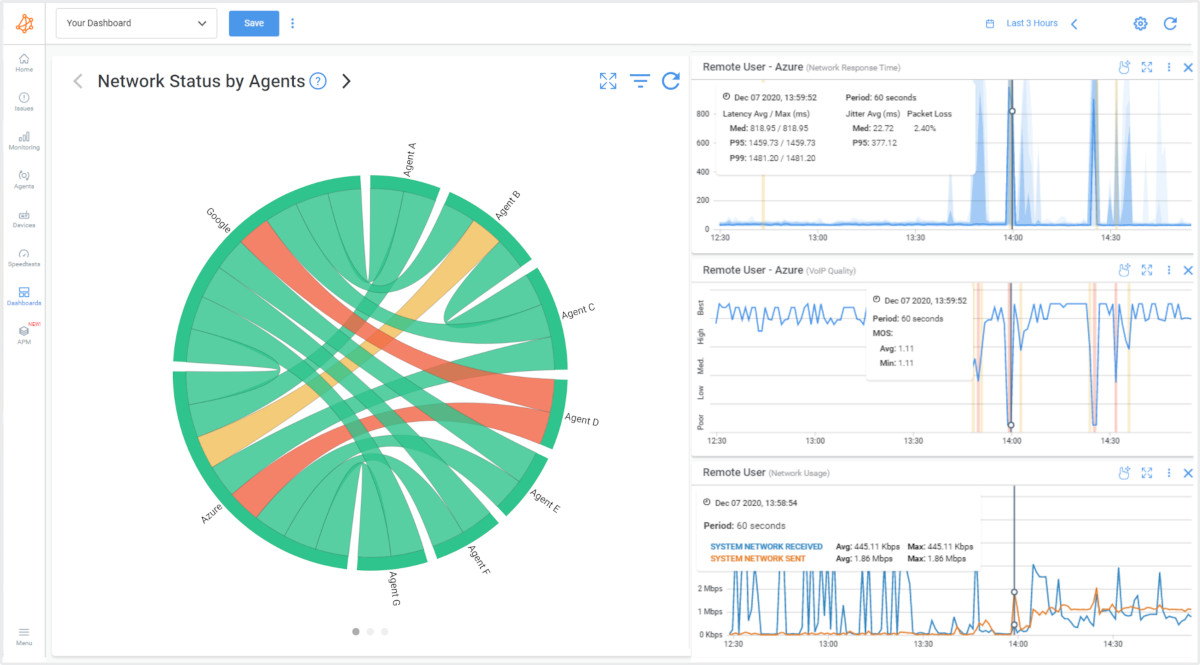
Here's why it's a game-changer for MSPs:
Rapid Issue Detection: Obkio spots network problems fast. No need to waste time figuring out what went wrong. It's a quick troubleshooter, ensuring downtime is minimized.
Efficient Issue Resolution: It's not just about finding problems; it's about fixing them pronto. Obkio helps you resolve glitches swiftly, maintaining the health of both your network and your clients, ensuring uninterrupted availability.
Peace of Mind: With Obkio, you can relax. No more sleepless nights worrying about network issues. It's like having a reliable partner watching your back, ensuring your networks stay up and running.
Happy Clients: A smooth network means happy clients. Obkio ensures both MSP networks and clients' networks stay happy, which means your MSP life stays stress-free. It's the ultimate formula for maintaining network uptime and availability while swiftly detecting and addressing any issues that might pop up.
Obkio’s MSP Network Monitoring Solution is your no-nonsense ally in keeping networks healthy and operational. It’s efficient, effective, and your ticket to a hassle-free MSP journey.

Obkio employs a distinctive software solution known as Monitoring Agents to oversee network performance. These agents are specialized software installations strategically placed at each endpoint throughout your distributed network. Their primary function is to systematically monitor decentralized locations, identifying potential network issues across various points such as applications, the Internet, and every corner of your network infrastructure.
The Monitoring Agents facilitate the exchange of Synthetic Traffic every 500 milliseconds, meticulously evaluating performance between distinct network locations, encompassing branch offices, head offices, data centers, clouds, and internet connections. This distributed network monitoring approach proves especially advantageous for MSPs aiming to track performance across multiple network locations, including those of their clientele.
To unleash the full capabilities of Obkio's Network Monitoring tool, MSPs embark on their journey by deploying Monitoring Agents within their local network infrastructure.
- Local Agents (Windows, MacOS, Linux, Hardware) are installed at key network locations such as branch offices, data centers, and remote locations to monitor performance.
- Public Monitoring Agents are Agents installed in Service Provider networks (like AWS, Google, and Azure). They can be used to monitor the performance of any branch externally towards the Internet (without passing through the head office).
Some MSPs also choose to host their own Public Monitoring Agents, so their customers can monitor network performance up to the MSP network infrastructure, with pre-deployed Agents.
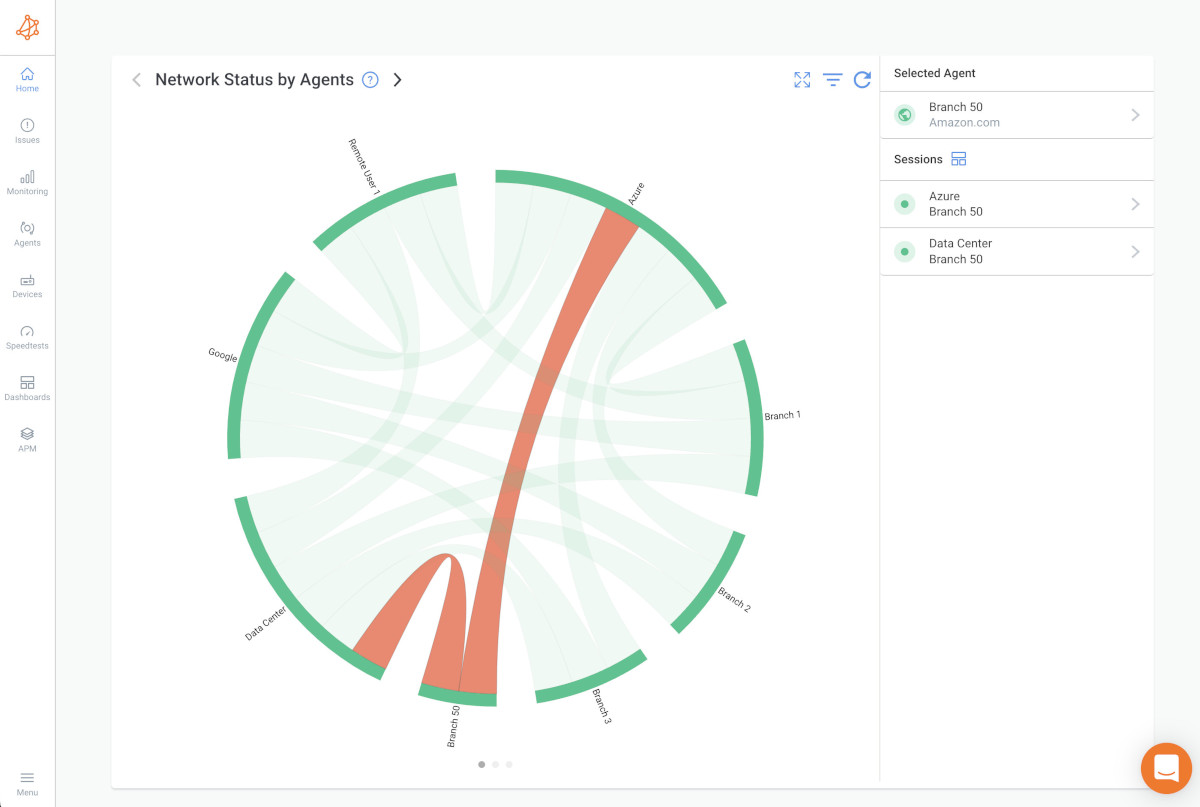
When Deploying Monitoring Agents in the MSP network, here are some things to keep in mind:
- End-to-End Distribution: Choose strategic locations within your network where Monitoring Agents will be deployed. These locations should offer comprehensive coverage and insight into network segments that require monitoring.
- Agent Deployment: Install Obkio's Monitoring Agents in the selected locations. This process is straightforward and well-guided, ensuring a seamless setup even for non-technical users.
- Continuous Monitoring: Once deployed, Monitoring Agents continuously monitor network traffic, latency, bandwidth utilization, and other critical performance indicators. This surveillance operates in the background, providing real-time data without interrupting your network operations.
- Performance Data: The data collected by Monitoring Agents is meticulously analyzed by Obkio's advanced algorithms, generating comprehensive performance reports and visualizations. These insights offer a clear picture of network health, enabling you to identify issues, optimize resources, and make informed decisions.
- Ensuring Customer Satisfaction: By monitoring your network with precision, Monitoring Agents enable you to ensure the seamless functioning of your services. Timely identification of performance hiccups empowers you to address them proactively, minimizing disruptions and maintaining service excellence.
As MSPs take on the responsibility of managing not only their networks but also those of their clients, gaining visibility into client networks becomes paramount for identifying and addressing service issues effectively.
Monitoring the performance of MSP’s services in their customer networks, pinpointing potential problems, and delivering impactful solutions requires a proactive approach. Extend your monitoring capabilities by deploying Monitoring Agents across all client networks.
Statistics reveal that a significant 80% of customer service calls to Service Providers are linked to LAN and wireless issues on the clients' ends. Obkio intervenes to end the ping-pong blame game between customers' support teams by substantiating that the network is not the culprit.
This way, customers can focus on resolving the issue on their end without compromising your reputation as a Service Provider. Obkio empowers MSPs to enhance their service quality, foster smoother collaborations with clients, and maintain a sterling reputation in the ever-evolving landscape of network management.
When Monitoring Your Customers’ Network Performance:
- Customer Network Visibility: Collaborate with your clients to seamlessly integrate Obkio's Monitoring Agents into their networks. This partnership marks a proactive step towards enhancing network performance and troubleshooting capabilities.
- Strategic Deployment: Place Monitoring Agents strategically within each client's network, mirroring the approach taken within your own infrastructure. These agents will monitor network performance from your clients' networks, extending visibility and understanding into the intricate layers of their operations.
- Customer and Service Performance Insights: The Monitoring Agents gather invaluable data about your clients' network traffic, latency, and overall performance. This data is then translated into comprehensive reports and visualizations, offering insights that empower you and your clients to make informed decisions.
- Collaborative Troubleshooting: With a holistic view spanning from your clients' networks up to your own, you're equipped to trace the origin of network issues. This collaborative troubleshooting approach eradicates guesswork, accelerates issue resolution, and fosters a deeper sense of partnership between you and your clients.
So, picture this: you've got these Monitoring Agents seamlessly woven into your own network and your clients' networks. And bam! You're on this cool journey of truly understanding everything about your networks. Obkio's Network Monitoring tool makes you a superhero MSP, breaking through the usual barriers.
Getting those Obkio Monitoring Agents into your network and your clients' networks is a big move toward mastering network management. But, here's the real kicker – it's not just about the initial setup; it transforms into this constant flow of synthetic traffic. That means your ability to keep an eye on network performance across all the connected dots gets a serious boost.
Once all the Monitoring Agents are in action, they kick off this ongoing exchange of synthetic traffic. It's not just about monitoring individual network performance; it's about gaining insights into how your MSP network and your clients' networks dynamically interact.
Using Obkio, MSPs can collect a diverse set of performance data about both their own network and their customer networks to ensure optimal functionality and troubleshoot potential issues.
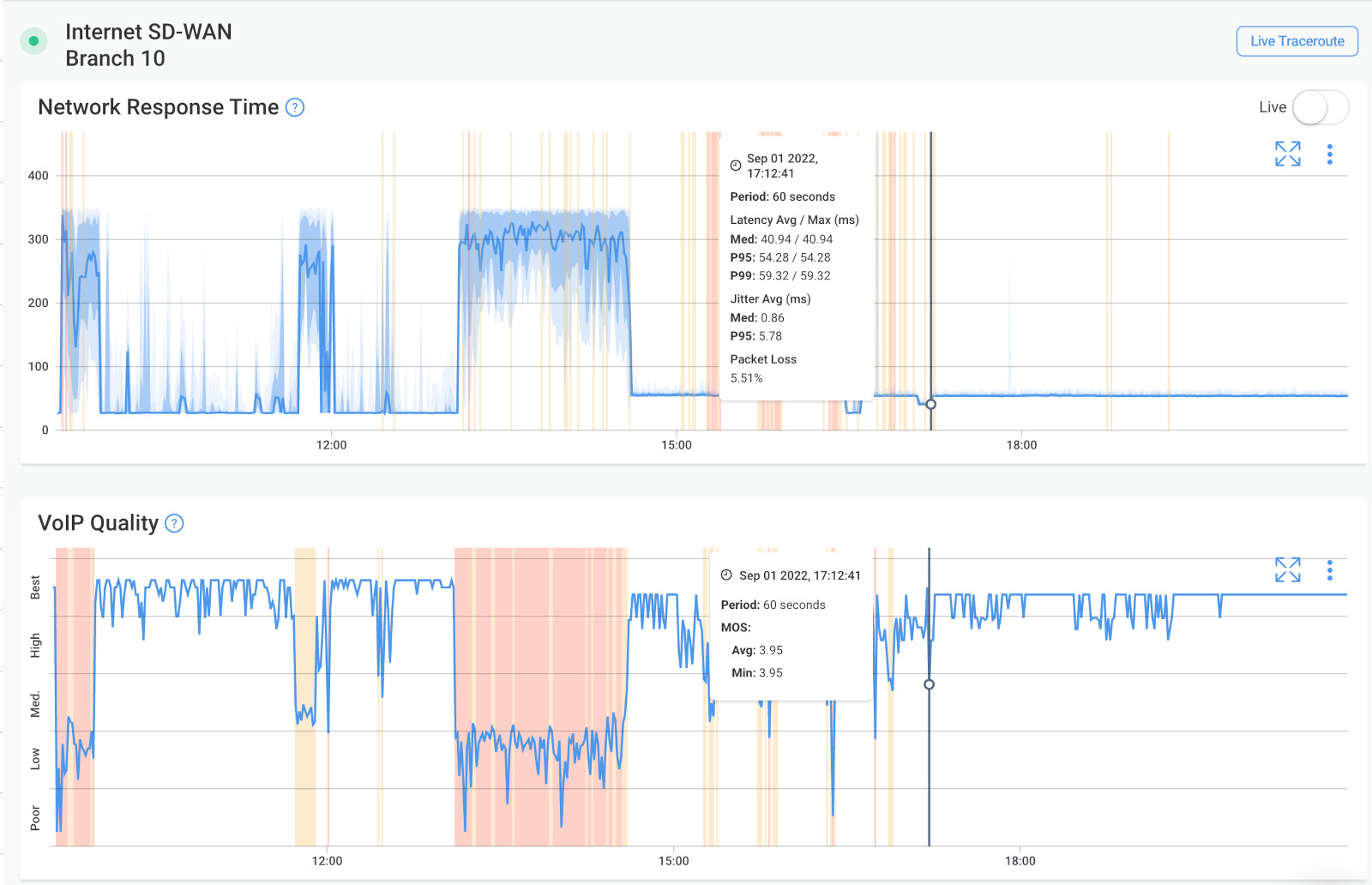
- Bandwidth Utilization: Measure the amount of data transmitted and received over the network to ensure that it aligns with the allocated bandwidth and identify potential bottlenecks.
- Latency: Evaluate the time it takes for data to travel from one point to another. Low latency is crucial for real-time applications and services like VoIP (VoIP latency).
- Packet Loss: Monitor the percentage of data packets lost during transmission. Packet loss can impact the quality and reliability of communication.
- Jitter: Assess the variation in latency over time, as inconsistent latency (jitter) can affect the performance of voice and video applications.
- Network Availability: Track the percentage of time the network is operational. High network availability is critical to ensuring that services are consistently accessible.
- Device Health: Monitor the status and health of network devices, including routers, switches, and servers, to identify potential hardware issues.
- Application Performance: Evaluate the performance of critical applications to ensure they meet service level agreements (SLAs) and provide a positive user experience.
- Security Metrics: Keep an eye on security-related metrics, including intrusion attempts, firewall activity, and anomalies in network traffic that could indicate potential security threats.
- Client Connectivity: Check the connectivity and performance from client devices to network resources, ensuring that end-users experience seamless access to services.
- Cloud Service Performance: If applicable, monitor the performance of cloud-based services and applications to ensure they meet performance expectations.
- Wireless Network Metrics: For networks incorporating wireless components, assess metrics like signal strength, interference, and the number of connected devices to optimize wireless performance.
By gathering and analyzing this performance data, MSPs can proactively address issues, optimize network efficiency, and provide clients with a reliable and high-performing IT infrastructure. These metrics contribute to a comprehensive understanding of the network ecosystem, supporting informed decision-making and enhancing overall service delivery.
Real-time monitoring involves the continuous, immediate observation of network performance metrics as they happen. In the realm of MSP networks, real-time monitoring is like having a live dashboard that provides up-to-the-second insights into the health and activities of the network.
Obkio excels in real-time monitoring by offering instantaneous visibility into critical metrics such as bandwidth utilization, latency, packet loss, and more. MSPs can promptly identify and respond to issues as they arise, minimizing downtime and ensuring optimal performance.
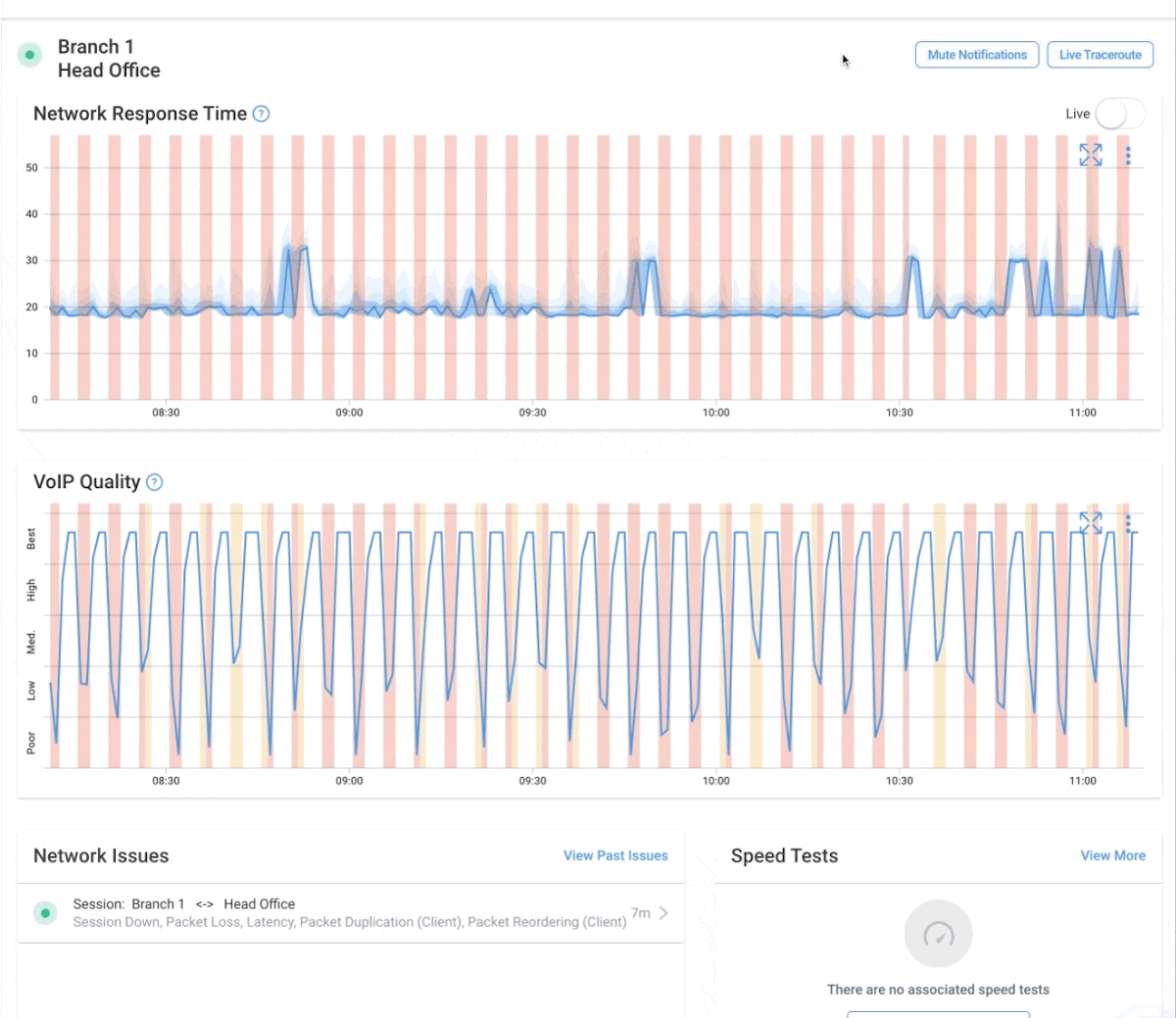
Key Aspects of Real-time Monitoring with Obkio:
- Instantaneous Insights: Obkio's real-time monitoring provides instant updates on network performance, allowing MSPs to catch and address issues in the moment.
- Proactive Issue Detection: With live data, MSPs can proactively detect and troubleshoot network anomalies, reducing the impact on services and end-users.
- Dynamic Network Visibility: MSPs gain dynamic, on-the-fly visibility into the current state of the network, enabling swift decision-making based on real-time conditions.
While real-time monitoring focuses on the present, historical analysis involves reviewing past network performance data to identify trends, patterns, and potential areas for improvement. Obkio's historical analysis tools enable MSPs to delve into performance data over extended periods.
This retrospective approach aids in understanding long-term network behaviour, planning for capacity, and making informed decisions for future enhancements.
- Long-term Performance Trends: Obkio retains historical data, allowing MSPs to analyze performance trends over days, weeks, or months.
- Capacity Planning: Historical analysis assists MSPs in forecasting and planning for future network requirements based on past usage patterns.
- Root Cause Analysis: By examining historical data, MSPs can perform root cause analysis for recurring issues, leading to more effective preventive measures.
Effectively monitoring MSP networks requires a balance between real-time insights and historical context. While real-time monitoring ensures immediate responsiveness to current issues, historical analysis provides a strategic understanding of network performance trends.
Together, they empower MSPs with a comprehensive approach to network oversight, enabling them to not only address current challenges promptly but also to make informed decisions that enhance the overall resilience and efficiency of their networks over time.

In the world of MSPs maintaining robust network performance and security is non-negotiable. To achieve this, MSPs need to deploy a comprehensive monitoring strategy. In this section, we'll delve into the various facets that MSPs should vigilantly monitor within their networks.
At the core of effective network management lies the continuous monitoring of key performance metrics. These metrics are at the heart of maintaining availability and uptime.
- Bandwidth Utilization: Regularly monitor bandwidth usage to ensure it aligns with the allocated capacity, preventing congestion and slowdowns.
- Latency: Continuously track latency to maintain optimal responsiveness for applications, especially those requiring real-time communication.
- Packet Loss: Measure packet loss rates to identify potential issues with data integrity and minimize disruptions.
- Jitter: Keep an eye on jitter to ensure stable and consistent latency, crucial for the quality of real-time applications.
- Network Uptime: Ensure the network remains operational and accessible to users without interruptions with high network uptime.
- Network Availability: Monitor the percentage of time the network is operational, ensuring consistent access to services.
In an era where cybersecurity is a top priority, monitoring security metrics is imperative for MSPs. Examining firewall activity, intrusion detection, and anomaly detection allows MSPs to safeguard network integrity.
- Firewall Activity: Regularly review firewall logs for any unusual or unauthorized activities, ensuring that the network perimeter is secure.
- Intrusion Detection: Implement systems that can detect and respond to any attempts at unauthorized access or security breaches.
- Anomaly Detection: Employ tools that analyze network traffic for unusual patterns, helping identify potential security threats and anomalies.
The heartbeat of any network lies in the health of its devices. Regular check-ups on routers, switches, servers, and other components are essential for identifying and addressing potential hardware issues.
Regularly check the status and performance of routers, switches, servers, and other network devices to identify and address potential hardware issues promptly.
Applications are the lifeblood of any network, and their optimal performance is non-negotiable. Monitoring the performance of critical applications ensures that service level agreements (SLAs) are met, and users experience a seamless digital environment
The end-user experience is paramount, and client connectivity is at the heart of it. Monitoring how client devices connect and interact with the network resources ensures a seamless and responsive user experience.
Evaluate the connectivity and performance experienced by client devices, ensuring seamless access to network resources.
With the increasing reliance on cloud services, monitoring their performance is crucial for MSPs. Whether it's optimizing cloud-based applications or ensuring smooth integration with on-premises infrastructure, understanding cloud service performance is key.
Monitor the performance of cloud-based applications and ensure smooth integration with on-premises infrastructure.
The wireless network is a critical component in today's connected world. Assess wireless network metrics such as signal strength, interference, and the number of connected devices to optimize performance and coverage.
The efficient utilization of bandwidth is central to a well-functioning network. Analyze data transfer rates and traffic patterns to optimize bandwidth usage, identify potential congestion points, and plan for network capacity upgrades.
The devil is in the details, especially when it comes to network configuration. Regularly review and validate the configuration settings of network devices and applications to prevent misconfigurations that can lead to performance issues.
Redundancy and network failover systems are the safety nets of a resilient network. Monitor the effectiveness of redundancy systems and failover mechanisms to ensure network reliability and continuity in case of failures.
Predicting the future is a challenge, but in the realm of network management, it's a necessity. Quality of Service (QoS) is the linchpin in delivering a consistent and prioritized network experience. Implement and monitor QoS settings to ensure the prioritized delivery of network resources for critical applications, ensuring a consistent user experience.
Analyze historical data to forecast network growth, plan for capacity upgrades, and ensure resource availability to meet future demands.
By monitoring these aspects, MSPs can maintain a proactive stance in managing their networks, ensuring optimal performance, security, and reliability. Utilizing advanced network monitoring tools like Obkio provides real-time insights and historical data, streamlining the monitoring process and enabling more effective network management.
Unlock ISP Network Monitoring's transformative power for proactive issue detection and seamless client support, reshaping the competitive landscape.
Learn more

For MSPs, the ability to foresee and address network issues before they disrupt services is especially crucial for maintaining high customer satisfaction and a competitive edge.
In this section, we explore the art of proactive issue identification with Obkio's advanced monitoring tools. From distinguishing between MSP and customer network issues to implementing real-time alerts and insights into common challenges, discover how Obkio empowers MSPs to navigate the complexities of network management with precision and foresight.
Understanding the nuances between MSP network issues and those in customer networks is crucial for effective problem resolution. MSP network issues could encompass challenges within the internal infrastructure, such as server downtimes or connectivity problems.
On the other hand, issues in customer networks might involve disruptions to specific services, connectivity troubles, or application performance concerns. Distinguishing between the two allows MSPs to deploy targeted solutions promptly.
The proactive identification of issues hinges on robust alerting and notification systems. Obkio facilitates this through customizable alerts that notify MSPs in real-time when predefined thresholds or anomalies are detected.
Whether it's a sudden spike in latency, an increase in packet loss, network drops, or a drop in bandwidth, Obkio's alerting system ensures MSPs are promptly informed, enabling swift action to prevent or mitigate issues.
- Customizable Alerts: Obkio allows MSPs to set up network monitoring alerts tailored to specific performance metrics and thresholds, ensuring that they receive notifications for issues that matter most.
- Real-time Notifications: The real-time nature of Obkio's alerts ensures that MSPs are promptly informed of any deviations from normal network behaviour.
- Preventive Action: By proactively identifying issues, MSPs can take preventive measures, minimizing the impact on both their internal network and customer networks.
- Minimized Downtime: Proactively addressing issues before they escalate minimizes downtime, ensuring optimal network availability.
- Enhanced Service Quality: Early detection and resolution of issues contribute to a consistent and high-quality service experience for both MSPs and their clients.
- Client Satisfaction: MSPs can demonstrate reliability and responsiveness, leading to increased client satisfaction and trust.

Proactive issue identification requires an understanding of common challenges that MSPs may encounter in their networks. Obkio's monitoring tool is designed to detect these issues early on, helping MSPs address them before they escalate and impact service delivery.
But to give you a head start, let’s go through the various performance issues that pop up in MSP networks:
Bandwidth Congestion: Insufficient bandwidth can lead to network congestion, resulting in slow data transfer, delayed responses, and degraded network performance.
Latency: High latency can cause delays in data transmission, impacting the responsiveness of applications and services. This is particularly critical for real-time applications.
Packet Loss: Packet loss occurs when data packets fail to reach their destination. This can result in retransmissions, degraded voice and video quality, and overall poor network performance.
Network Jitter: Jitter refers to the variation in packet arrival times. Inconsistent jitter can affect the quality of real-time applications, such as voice and video communication.
Security Breaches: Security issues, including unauthorized access, malware infections, or other cyber threats, can compromise the integrity and confidentiality of data, leading to performance issues.
Hardware Failures: Malfunctions or failures of networking hardware, such as routers, switches, or servers, can disrupt network operations and impact service availability.
Software Glitches: Issues with software components, including operating systems, applications, or middleware, can lead to performance degradation and operational disruptions.
Configuration Errors: Misconfigurations in network devices or applications can result in unintended consequences, causing performance issues and potential service disruptions.
Inefficient Cloud Integration: MSP networks increasingly rely on cloud services. Inefficient integration with cloud resources can lead to performance bottlenecks and connectivity issues.
Poor Quality of Service (QoS): Inconsistent or inadequate QoS settings can lead to uneven distribution of network resources, impacting the quality of service for critical applications.
Client Connectivity Issues: Problems with client devices, such as connectivity issues or outdated hardware, can contribute to performance challenges within the network.
Lack of Redundancy: Insufficient redundancy in critical components can lead to single points of failure, resulting in service interruptions and decreased network reliability.
Addressing these common performance issues requires a proactive and strategic approach to network management.
In essence, proactively identifying issues in MSP networks involves a combination of understanding the unique challenges within both the MSP's internal infrastructure and customer networks, implementing effective alerts and notifications, and addressing common network issues before they impact services. With Obkio's proactive Network Monitoring tool, MSPs can navigate the intricacies of network management with precision and efficiency.


Now, let’s dive into the pivotal use cases that underscore why MSP network visibility is not just an option but an absolute necessity. From safeguarding high availability and uptime to ensuring services seamlessly operate in customer networks, eliminating the back-and-forth communication quandaries, and steadfastly monitoring and adhering to SLAs, we explore how network visibility empowers MSPs to navigate challenges with precision and enhance the overall quality of service delivery.
High network availability and network uptime are non-negotiable for MSPs. Downtime not only impacts internal operations but also disrupts the delivery of services to clients. Network visibility allows MSPs to proactively identify and address potential issues that could lead to downtime, ensuring continuous and reliable network operations.
How MSPs Achieve This: Through continuous monitoring of network performance metrics such as latency, packet loss, and bandwidth utilization, MSPs can identify anomalies and potential points of failure. This proactive approach enables them to address issues before they escalate, minimizing downtime and optimizing network availability.
MSPs are responsible for delivering a range of services to their clients, and these services often rely on a well-functioning network. Visibility into customer networks is crucial for MSPs to ensure that their services are operating seamlessly. Any disruptions or issues need to be identified promptly to maintain the quality of service delivered to clients.
How MSPs Achieve This: Utilize network monitoring tools that offer end-to-end visibility into both the MSP's infrastructure and customer networks, like Obkio. This allows MSPs to detect performance issues, troubleshoot problems, and ensure that their services are functioning optimally in the customer environment.
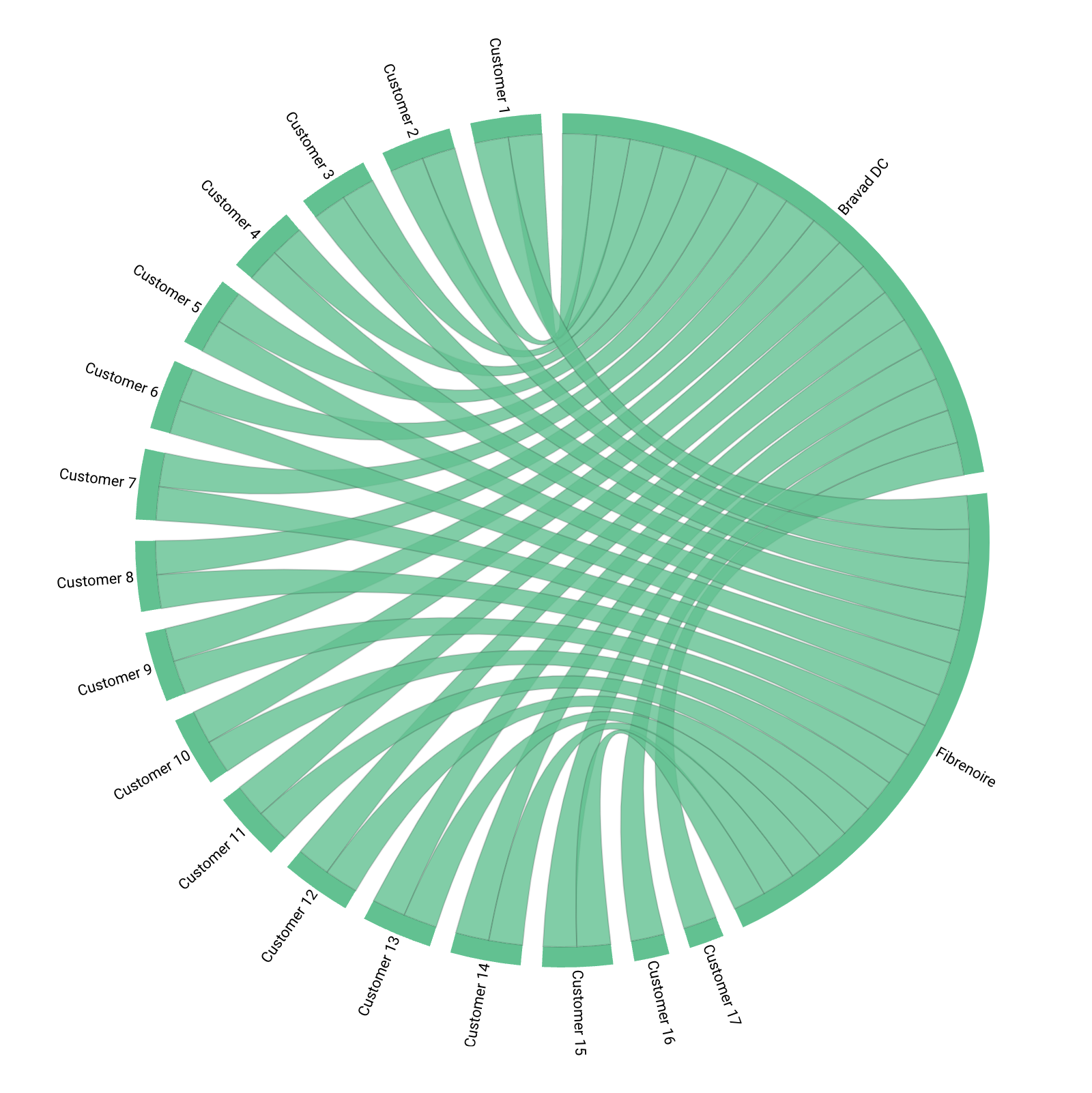
3. Avoiding the Back and Forth Between MSPs and Customers When Identifying Where Issues Are Coming From
The classic "blame game" between MSPs and customers when issues arise can be detrimental to relationships. Network visibility enables MSPs to quickly pinpoint the source of issues, avoiding prolonged back-and-forth discussions and expediting the resolution process. This not only saves time but also enhances transparency and trust between the MSP and their clients.
How MSPs Achieve This: By providing detailed insights into network performance and identifying the exact location and nature of issues. This empowers MSPs to communicate effectively with clients, demonstrating a clear understanding of the problem and a proactive approach to resolution.
Service Level Agreements (SLAs) are the backbone of the relationship between MSPs and their clients. Monitoring network performance is essential to meet and exceed SLA commitments. Network visibility ensures that MSPs can track and report on key metrics, demonstrating their adherence to SLAs and maintaining a high standard of service.
How MSPs Achieve This: Through continuous monitoring of performance metrics aligned with SLA requirements. SLA monitoring includes tracking latency, uptime, response times, and other parameters defined in SLAs. Real-time insights and historical data provide evidence of adherence to SLAs and support transparent communication with clients.
In summary, network visibility is a linchpin for MSPs, offering insights and capabilities crucial for maintaining high availability, delivering seamless services to clients, avoiding unnecessary communication challenges, and ensuring adherence to SLAs. Advanced network monitoring tools, such as those provided by Obkio, play a pivotal role in empowering MSPs with the visibility they need to excel in these critical areas.
Learn about SLA monitoring & reporting using Network Monitoring to measure network, service performance, user experience & understand if SLAs are being met.
Learn more

Monitoring MSP network environments is not without its challenges. The diverse landscapes of client infrastructures, the constant need to predict and prevent service disruptions, and the overwhelming volume of alerts are hurdles that demand adept solutions. This section explores the challenges inherent in monitoring MSP networks and how cutting-edge Network Monitoring tools stand as beacons of resilience.
MSPs typically manage networks for multiple clients, each with unique configurations, hardware, and software. Monitoring diverse environments can be challenging, leading to difficulties in standardizing monitoring practices.
Solution: Network Monitoring tools provide customizable monitoring templates and profiles. This allows MSPs to adapt monitoring configurations to the specific needs of each client, ensuring a tailored approach for diverse environments.
MSPs often struggle to predict service issues within their IT infrastructure, leading to unexpected outages and disruptions in service availability.
Solution: Advanced Network Monitoring tools offer predictive analytics and anomaly detection. By analyzing historical data and identifying patterns, these tools can forecast potential issues, enabling MSPs to take proactive measures and prevent service disruptions.
Traditional monitoring solutions generate a large number of alerts for various events, leading to alert fatigue. MSPs may find it challenging to prioritize and respond to critical alerts promptly.
Solution: Network Monitoring tools feature intelligent alerting mechanisms. They use threshold customization and correlation algorithms to filter out noise, ensuring that MSPs receive alerts for significant issues that require immediate attention.
Outdated monitoring solutions may lack the ability to correlate events and identify patterns in IT events, making it difficult to predict and prevent performance issues.
Solution: Modern Network Monitoring tools employ event correlation techniques. By analyzing the relationships between different events, these tools can identify the root cause of network issues and provide a more comprehensive view of the network environment.
The size and complexity of modern IT infrastructures managed by MSPs can be overwhelming. This complexity may lead to challenges in resource allocation and efficient management.
Solution: Network Monitoring tools offer centralized network monitoring dashboards and automation features. They allow MSPs to manage large-scale IT infrastructures more efficiently by providing a consolidated view of network performance and automating routine monitoring tasks.
MSPs may struggle with poor visibility into the internal states of software systems, making it challenging to identify and resolve issues within applications.
Solution: Network Monitoring tools with application performance monitoring capabilities offer deeper insights into software systems using Application Performance Monitoring (APM). They track application behavior, response times, and resource utilization, providing MSPs with a comprehensive view of software performance.
Meeting Service Level Agreements (SLAs) is a critical aspect of MSP service delivery. Without proper monitoring, it can be challenging to demonstrate adherence to SLA commitments.
Solution: Network Monitoring tools provide real-time and historical data on key performance metrics aligned with SLAs. MSPs can use this data to generate reports and evidence of compliance with SLA requirements.
In summary, Network Monitoring tools play a crucial role in overcoming the challenges faced by MSPs. By providing customizable and adaptive monitoring, predictive analytics, intelligent alerting, event correlation, centralized management, application performance insights, and SLA adherence support, these tools empower MSPs to deliver high-quality services in dynamic and diverse network environments.
Efficient bandwidth utilization not only enhances the overall performance of the network but is also instrumental in delivering seamless services to clients. Here, we explore some best practices for monitoring and optimizing bandwidth utilization in MSP networks.
Real-Time Monitoring: Implementing real-time bandwidth monitoring allows MSPs to gain immediate insights into network usage patterns. This visibility enables quick identification of bandwidth-hungry applications or users.
Historical Analysis: Analyzing historical bandwidth data provides MSPs with trends and patterns, facilitating informed decision-making. It helps identify peak usage times and plan for future bandwidth requirements.
Granular Traffic Analysis: Utilizing network monitoring tools that offer granular traffic analysis allows MSPs to understand the types of traffic-consuming bandwidth. This insight aids in prioritizing critical applications and managing non-essential traffic.
Load Balancing: Implementing load balancing distributes network traffic across multiple paths or devices, preventing bottlenecks and ensuring optimal use of available bandwidth. MSPs can deploy load-balancing solutions to evenly distribute traffic and enhance overall network performance.
Quality of Service (QoS) Implementation: Prioritizing network traffic based on application criticality is essential. QoS allows MSPs to allocate bandwidth to critical applications, ensuring that important services receive the necessary resources for optimal performance.
Traffic Shaping: MSPs can employ traffic shaping techniques to control the flow of data, preventing network congestion. This strategy involves prioritizing or limiting certain types of traffic to ensure a balanced and efficient use of available bandwidth.
Content Delivery Network (CDN) Integration: Leveraging CDNs for content delivery can significantly reduce the strain on the MSP network. By caching and delivering content from geographically distributed servers, CDNs minimize the need for extensive bandwidth usage.
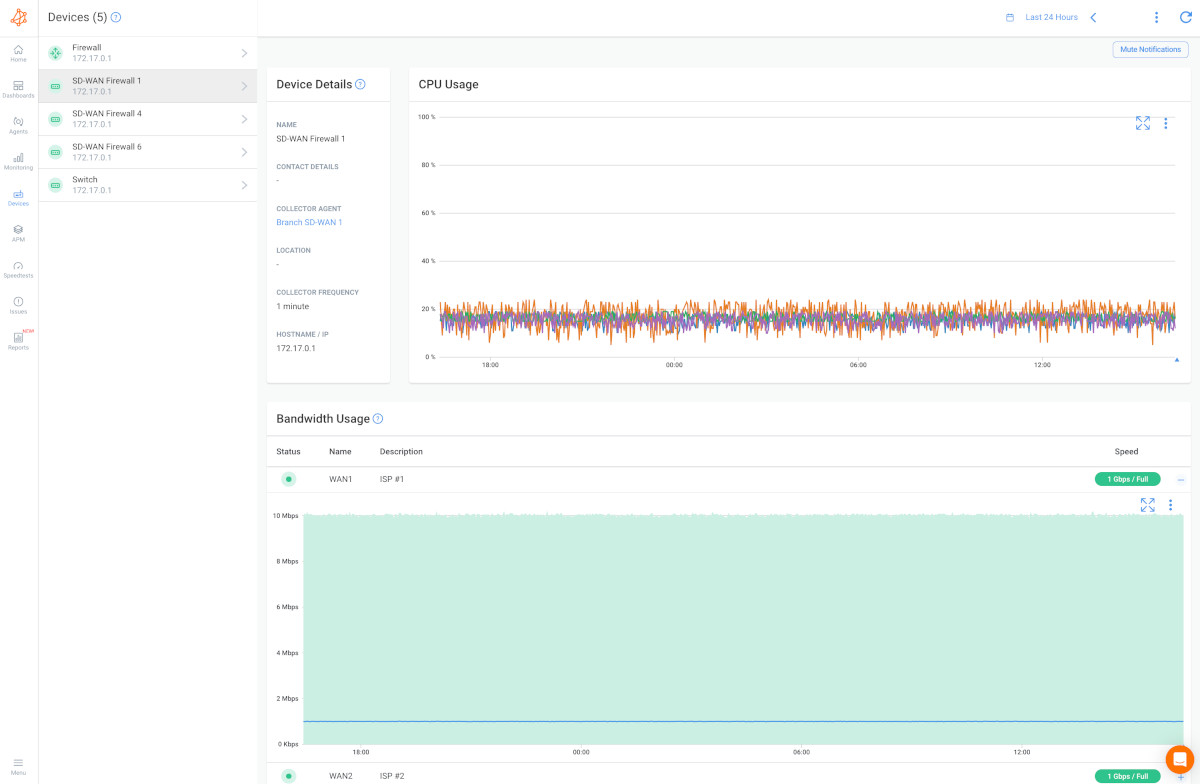
Automated Scaling: Utilizing network monitoring tools that support automated scaling enables MSPs to dynamically allocate additional bandwidth when needed. This ensures that the network can adapt to varying demands without compromising performance.
Flexible Bandwidth Plans: Offering clients flexible bandwidth plans allows MSPs to align their services with client needs. This adaptability ensures that clients have access to the required bandwidth during peak times without paying for excess network capacity during periods of lower demand.
Application Optimization: Implementing optimization policies for specific applications can streamline their data usage. Techniques such as data compression and protocol optimization can reduce the amount of data transmitted, optimizing bandwidth consumption.
Effective client reporting and communication are integral components of building trust and ensuring transparent collaboration between the MSP network and customer networks. How can MSPs achieve this? Let’s explore:
Key Performance Metrics:
MSPs must include key performance metrics in their reports to provide clients with a comprehensive overview of network health. This may include metrics such as latency, bandwidth utilization, packet loss, and uptime. These metrics serve as vital indicators of network performance and reliability.
Incident and Issue Logs:
Including incident and issue logs in reports allows clients to understand the historical context of network events. MSPs can provide details on resolved incidents, ongoing issues, and the actions taken to address them. This transparency fosters a sense of trust and demonstrates the MSP's commitment to proactive network management.
Trend Analysis:
Reports should incorporate trend analysis to highlight any emerging patterns or recurrent issues. This predictive aspect helps clients anticipate potential challenges and align their business strategies accordingly.
Customization:
Providing customizable reports allows MSPs to tailor information to the specific needs of each client. Clients may have different priorities and preferences, and the ability to customize reports ensures that they receive relevant and meaningful insights.

Regular Status Updates:
Establishing a routine for regular status updates ensures consistent communication between MSPs and their clients. Whether through scheduled meetings, automated email updates, or a dedicated client portal, providing regular updates on network health reinforces transparency and keeps clients informed.
Clear Incident Notifications:
In the event of incidents or disruptions, clear and timely notifications are crucial. MSPs should communicate the nature of the issue, its impact on services, and the steps being taken for resolution. Transparent communication during incidents helps manage client expectations and builds confidence in the MSP's ability to handle challenges.
Performance Reviews:
Conducting periodic performance reviews with clients allows MSPs to discuss the overall health of the network, review key metrics, and address any concerns or opportunities for improvement. These reviews provide an open forum for collaboration and strategic planning.
Interactive Dashboards:
Implementing client-facing portals with interactive dashboards allows clients to access real-time network performance data. These dashboards provide clients with a self-service option to monitor network health, view historical trends, and access relevant reports.
Customizable Views:
Offering customizable views within client-facing portals allows clients to prioritize and focus on the metrics that matter most to them. This flexibility enhances the client experience and ensures that they can easily access the information relevant to their specific needs.
In essence, effective client reporting and communication are pivotal aspects of successful MSP-client relationships. By creating comprehensive and understandable reports, and embracing transparent communication practices, MSPs can not only meet but exceed client expectations. This proactive approach fosters a collaborative partnership where clients are empowered with insights, trust is strengthened, and the overall network health is optimized.
In the world of MSPs, the journey of MSP network monitoring demands precision, adaptability, and unwavering commitment. From ensuring high availability and seamless service delivery to overcoming the nuanced challenges of diverse client environments, the path to success is illuminated by one constant: visibility. Through the lens of this blog post, we've explored the critical facets of MSP network monitoring — from understanding network environments to optimizing bandwidth, fostering transparent communication, and beyond.
As we weave through the complexities of monitoring MSP networks and IT infrastructures, Network Monitoring tools become an MSP’s lifesaver! In this realm, Obkio emerges as a beacon of innovation and reliability. Tailored specifically for MSPs and network admins, Obkio's Network Monitoring tool empowers you to transcend conventional boundaries. With real-time insights, predictive analytics, and customizable reporting, Obkio ensures that your networks not only meet but exceed client expectations.

The future of MSP network management is dynamic, and the journey forward demands a partner who understands the intricacies of your role. Embrace the power of Obkio and revolutionize the way you monitor, manage, and excel in the ever-evolving landscape of MSP networks.
Ready to Elevate Your Network Monitoring?
- 14-day free trial of all premium features
- Deploy in just 10 minutes
- Monitor performance in all key network locations
- Measure real-time network metrics
- Identify and troubleshoot live network problems



























 Obkio Blog
Obkio Blog





